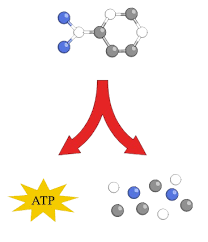Anabolism refers to the metabolic processes in living organisms where complex molecules are synthesized from simpler ones. This process requires energy, usually sourced from molecules like ATP (Adenosine Triphosphate), and involves the assembly of smaller molecules into larger, more complex ones. Anabolic processes are crucial for growth, repair, and maintenance of tissues and organs in the body
Catabolism, on the other hand, refers to the metabolic processes where complex molecules are broken down into simpler ones, releasing energy in the process. This energy is often captured in the form of ATP or other high-energy molecules and is utilized for cellular activities and other metabolic processes.
Table of Contents
Anabolism
The metabolic processes in which complex molecules are created from simpler ones in living things are referred to as anabolism. The assembling of smaller molecules into larger, more complicated ones is a necessary step in this process, which requires energy, which is often obtained from molecules like ATP (adenosine triphosphate). The body’s tissues and organs depend on anabolic processes for growth, maintenance, and repair. The synthesis of proteins, DNA replication, carbohydrates, lipogenesis (the creation of lipids), and photosynthesis in plants are a few examples of anabolic processes.

Catabolism
The metabolic process in which complex molecules are broken down into simpler ones is called catabolism. Energy released during this process is usually caught in the form of reduced coenzymes like FADH2 (flavin adenine dinucleotide) and NADH (nicotinamide adenine dinucleotide) or high-energy molecules like ATP (adenosine triphosphate). The recycling of nutrients and the production of energy for cellular functions and other metabolic processes depend heavily on catabolic reactions. The breakdown of proteins by proteolysis, beta-oxidation of fatty acids, and glycolysis are a few examples of catabolic processes.

13 Key Differences between Anabolism and Catabolism
| S.N | Aspect | Anabolism | Catabolism |
| 1. | Definition | The process of synthesizing complex molecules from simpler ones. | The process of breaking down complex molecules into simpler ones. |
| 2. | Location | Its occurs in the mitochondria, endoplasmic reticulum, and cytoplasm, among other biological compartments. | Its primarily occurs in the cytoplasm and mitochondria. |
| 3. | Substrates | It uses small precursor molecules as substrates. | It breaks down large molecules into smaller ones. |
| 4. | ATP Consumption | It consumes ATP for energy. | It generates ATP as a byproduct. |
| 5. | Primary Purpose | It facilitates growth, repair, and maintenance of tissues and organs. | It provides energy for cellular activities and metabolic processes. |
| 6. | Enzymatic Regulation | It regulated by specific enzymes involved in biosynthetic pathways. | It regulated by specific enzymes involved in degradation pathways. |
| 7. | End Products | It produces complex molecules (e.g., proteins, carbohydrates). | It produces simpler molecules (e.g., glucose, fatty acids). |
| 8. | Energy Storage | It stores energy in chemical bonds of synthesized molecules. | It releases stored energy from chemical bonds of broken-down molecules. |
| 9. | Role in Metabolism | It is essential for anabolic processes and building cellular components. | It is essential for catabolic processes and releasing energy from nutrients. |
| 10. | Hormonal Regulation | It is controlled by hormones that promote growth and anabolic activities. | It is controlled by hormones that regulate energy metabolism and catabolic activities. |
| 11. | Cellular Response | It promotes cellular growth and differentiation. | It provides energy for cellular work and maintenance. |
| 12. | Role in Energy Balance | It contributes to energy storage and utilization for future use | It contributes to immediate energy needs and maintaining metabolic homeostasis. |
| 13. | Example | An example of anabolism is the synthesis of proteins from amino acids | It is the breakdown of glucose into pyruvate during glycolysis. |
Frequently Asked Question(FAQ)
What is Anabolism and Catabolism?
Anabolism refers to the metabolic processes in living organisms where complex molecules are synthesized from simpler ones. This process requires energy, usually sourced from molecules like ATP (Adenosine Triphosphate), and involves the assembly of smaller molecules into larger, more complex ones.
Catabolism, on the other hand, refers to the metabolic processes where complex molecules are broken down into simpler ones, releasing energy in the process.
What are the differences between Anabolism and Catabolism?
Definition:
The process of constructing complex molecules from simpler ones is known as anabolism.
The process of converting complicated molecules into simpler ones is known as catabolism.
Energy Needed:
Anabolism: Needs a source of energy.
Catabolism: Energy is released.
Where:
Anabolism takes place in the cytoplasm, endoplasmic reticulum, and mitochondria, among other cellular compartments.
Catabolism: Takes place mostly in the mitochondria and cytoplasm.
Substances:
Anabolism: Substrates are tiny precursor molecules.
Large molecules are broken down into smaller ones during catabolism.
Use of ATP:
Anabolism: Uses ATP as a fuel source.
ATP is produced as a consequence of catabolism.
Principal Goal:
Anabolism: Promotes tissue and organ growth, healing, and maintenance.
Energy for cellular functions and metabolic processes is obtained through catabolism.
Regulation by Enzymes:
Anabolism: Controlled by certain biosynthetic pathway enzymes.
Catabolism: Controlled by certain enzymes connected to processes of breakdown.
Related Article

